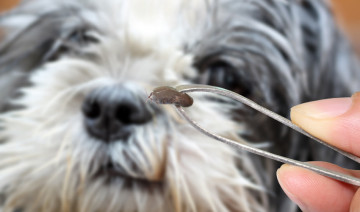10 Symptoms of Diabetes in Dogs
Diabetes can be a challenging condition to manage, especially in pets that cannot verbally communicate how they feel. Recognizing the symptoms of diabetes in...

Ticks can be persistent pests, and because they can transmit diseases to pets and pet owners alike, it is important to know where to look for ticks on your dog and how to remove them effectively. Fortunately, finding ticks isn’t hard if you know what types of environments ticks prefer.
Ticks are blood-sucking parasites related to spiders. They attach to a host animal to consume its blood, and stay attached and actively feeding for up to 8-10 days. During that time, they can transmit a variety of diseases to their host, including Lyme disease, Rocky Mountain spotted fever, and other illnesses, which can be fatal if left untreated. Different types of ticks can transmit different types of diseases, but each variety has similar preferences for habitat and environment, making it easy to check for all types of ticks on your dog.
Ticks prefer warm, humid environments, including damp tissue surfaces away from sunlight. On dogs, the most common places to find ticks include…
In addition to these common spots to find ticks on a dog, these parasites could appear anywhere on a dog’s body. Other likely spots for feeding ticks include:
Checking any likely spots very carefully is essential to be sure there are no ticks bothering or threatening your canine companion.
When you find a tick, it is essential to remove it quickly and safely to minimize the risk of disease transmission. To remove a tick from your dog…
After removing a tick, observe your dog closely for several days in case there are any symptoms of disease. If you have any concerns, consult your veterinarian immediately for a proper diagnosis and treatment regimen.
The best way to keep your dog tick-free is to avoid bites in the first place. Keep your pet from roaming in long grasses, under shrubbery, or in other damp areas where ticks may proliferate, and avoid contact with deer and other wildlife that may harbor ticks. Mowing grass slightly shorter will make your backyard habitat less tick-friendly as well. You can also keep your dog’s coat shorter and groom your pet frequently to be sure any ticks are spotted and removed right away. Inside your home, vacuum frequently and wash your dog’s bedding and toys in very hot water to eliminate any ticks. Using tick prevention medications on your pet and sprays outside to create tick barriers can also minimize the risk of attracting these unwanted parasites.
Ticks can be troublesome pests, but by understanding the type of environment these parasites prefer, you will know where to look for them on your pet and you will be better prepared to keep your dog tick-free.
We are constantly adding new specials to our site. Be sure to check back often!
We currently do not have any events scheduled.

Diabetes can be a challenging condition to manage, especially in pets that cannot verbally communicate how they feel. Recognizing the symptoms of diabetes in...
Comments